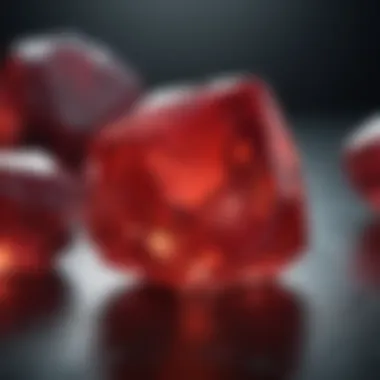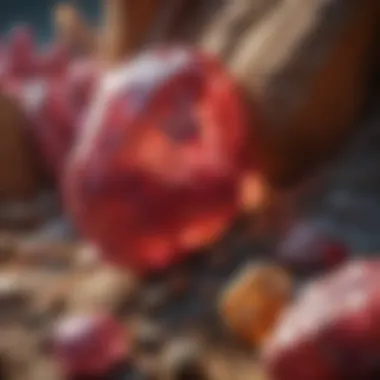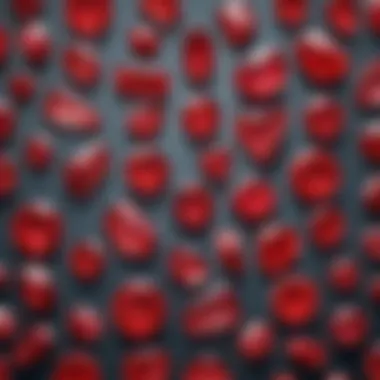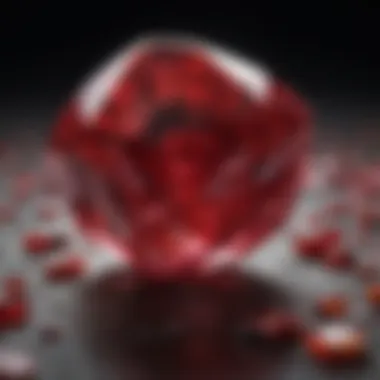Exploring Ruby Cristal: Properties, Significance, and Insights


Intro
Ruby cristal is a fascinating mineral that commands attention in both scientific and collector circles. Its vibrant color and distinct properties make it a subject of interest for many individuals who seek to understand the depth of specimen collection. This article intends to explore the properties of ruby cristal, examine its significance within mineralogy, and provide valuable insights for collectors. Through careful examination and organized guidance, readers will come away with a richer understanding and a practical approach to their passion.
Rock and Fossil Identification
In the realm of mineral collection, being able to accurately identify rocks and fossils is vital. Ruby cristal can be mistaken for other minerals if one is not careful. It's essential to know some key characteristics that distinguish ruby cristal from similar substances.
Types of Rocks and Fossils
Ruby cristal primarily comes from the corundum family of minerals, characterized by aluminum oxide. Other types, like sapphires, might look alike but tend to have different colors or impurities. Collectors should be aware of how ruby forms within metamorphic rocks, particularly within areas of high-grade metamorphism.
Characteristics to Look For
When identifying ruby cristal, certain traits are crucial:
- Color: A deep red hue, sometimes with purplish tones.
- Transparency: High transparency is valued; inclusions may reduce this value.
- Hardness: Ruby rates a 9 on the Mohs scale, indicating exceptional hardness.
- Luster: A vitreous shining surface can signify quality.
Eyeing these characteristics can help in the differentiation process, leading to more informed collection decisions.
Tools for Identification
Implementing the right tools can aid in identifying ruby cristal effectively. Consider the following:
- Loupe: A magnifying tool for examining inclusions or clarity.
- Scratch Test Kit: To verify hardness.
- Light Source: To analyze color and transparency under direct illumination.
Having the proper instruments ensures that collectors can authenticate their specimens accurately and efficiently.
Collecting Tips and Techniques
Gathering ruby cristal requires a tactical plan. Being aware of best practices aids in the efficiency and effectiveness of your collecting endeavors.
Best Practices for Collecting
When venturing out to collect, always prioritize responsible collection. Here are some best practices:
- Research Locations: Know the ins and outs of mineral-rich regions renowned for ruby মৃত্য misinformation crystals.
- Respect Regulations: Always follow local laws regarding collection.
- Use Ethically Sourced Materials: Collecting responsibly includes ensuring you take only what is allowed.
Locating Prime Collecting Sites
Certain geographical regions are known for excellent ruby discoveries. These include parts of Myanmar, Mozambique, and Thailand. Online platforms like reddit.com or minerological forums can provide additional insights into the spots that collectors should consider.
How to Safely Extract Specimens
When extracting ruby cristal from their locations, one must:
- Be Gentle: Avoid aggressive removal that can ruin the crystal.
- Manner of Extraction: Use tools like chisels or hammers, with caution to avoid excess damage to the formation.
- Safety Precautions: Utilize protective eyewear and gloves as necessary.
Following these techniques ensures both efficiency and safety during the excavation process.
Preservation and Display
After acquiring ruby cristal, preserving its quality becomes key. Moreover, display options should promote both aesthetics and safety.
Techniques for Preserving Rocks and Fossils
Proper preservation involves controlling conditions:
- Avoid Moisture: Moisture can lead to deterioration over time.
- Temperature Control: Keep at stable temperatures to prevent cracking.
Proper Storage Methods
Ideal storage scenarios can include:


- Display Cases: Airtight containers or glass cabinets ensure airflow while avoiding exposure to harmful environments.
- Safe Nesting: Placing specimens in padding helps avoid clashes that can create damage.
Creative Display Ideas
When it comes time to exhibit your collection, creativity can improve an exhibit's impact:
- Thematic Arrangement: Group by color or location for effect.
- Lighting: Utilize directed light sources to add depth to the displayed minerals.
These methodologies not only extend the life of the collection but heighten appreciation among viewers.
Geological Insights
Delving deeper into ruby cristal's geological insights showcases how minor facets can impact the larger narrative within mineralogy.
Geological Formations and Processes
Ruby cristal typically forms in metamorphic environments characterized by intense heat and pressure. Understanding these geological actions gives depth to the appreciation of this mineral.
Historical Significance of Rocks and Fossils
The historical impact of ruby cristal stretches across various cultures and influences trade and trade patterns, ofta being symbolic of power and wealth.
Notable Discoveries in the Field
Research continues to yield discoveries that advance our understanding of ruby cristal and its applications. Noteworthy advancements might be found on platforms such as en.wikipedia.org and britannica.com. Keeping current with innovations maintains engagement with the subject matter.
Through understanding, collecting, and appreciating ruby cristal, enthusiasts unveil not just minerals, but history itself.
In summation, the dynamic journey into the world of ruby cristal is packed with interest. By following this guide, one can immerse in the treasures this remarkable mineral has wil to offer.
Prelims to Ruby Cristal
Understanding Ruby Cristal is essential for both enthusiasts and serious collectors. This segment sets the framework for the fascinating world of ruby cristal, emphasizing its properties, significance, and market value. Grasping the nuances of ruby cristal helps collectors of various experience levels make informed choices. Furthermore, this section underlines the historical background that enriches the appreciation of this remarkable mineral.
Defining Ruby Cristal
Ruby Cristal is a variety of corundum, specifically known for its striking red hue. The vibrant color represents the presence of chromium, influencing both its beauty and desirability. This mineral not only serves as a breathtaking gemstone, but it also bears a significant geological footprint. Typically, ruby cristal emerges from metamorphic processes that involve intense heat and pressure. This geological origin contributes to its exceptional durability and suitability for various applications.
Collectors often seek ruby cristal beyond mere aesthetics. Its chemical stability allows for use in a wide range of settings, particularly in fine jewelry and ornamentation. Due to the combination of rarity and mesmerizing visual attributes, ruby cristal has carved a notable position within the esteemed minerals sought by collectors.
A Brief History of Ruby Cristal
The significance of ruby cristal stretches back to ancient times. Throughout history, it has been cherished across different cultures. Ancient civilizations viewed ruby cristal as a symbol of power and nobility. It was not only prized for its beauty but also believed to hold protective qualities. Notably, throughout the centuries, ruby cristal has adorned crowns and ceremonial objects, indicating its high status.
In regions where ruby crystallization occurs, artisans learned to craft intricate designs utilizing this mineral. Fascinatingly, the mining and trade of ruby cristal have created a longstanding economy for many related communities. Over time, the transparent and vivid characteristics of ruby cristal ignited an appreciation that spans the ages.
The allure of ruby cristal is as distinct as the mineral itself, broadening the horizons for collectors and contributing to our understanding of geology and history.
Understanding the origins and historical context elevates gratitude for ruby cristal beyond material value. Its role in cultural expressions, along with continuous inspiration in art and fashion throughout the wildlife, adds layers of context essential for any collector intending to embrace its essence.
Geological Background
Understanding the geological background of ruby cristal is essential for rock and mineral collectors. This background offers insight into formation processes and specific locations where ruby cristal can be found. By knowing where and how ruby cristal forms, collectors can appreciate its value and rarity more fully.
Formation Processes
Ruby cristal is a variety of corundum and gets its lovely red color from trace elements, primarily chromium. The process starts in high-temperature, high-pressure environments, often deep within the Earth’s mantle.
The most significant formation type is metamorphic, where existing minerals undergo reformation due to heat and pressure. Ruby often forms near limestone deposits as heat drives the transformation of aluminum-bearing minerals. Decomposed and altered rocks can yield rubies over millions of years. In some cases, the condition allows for spectacular crystals to grow, showcasing clarity and vibrant color.
In igneous processes, corundum can also form from cooling molten rock, particularly in regions rich in aluminum. This occurs in locations where igneous activities have occurred, pooling minerals that include sapphire and ruby. The interaction of these minerals often results in localized deposits that can range in size and quality.
Knowledge of such processes serves both as a guide and as a reference in identifying where one might locate ruby cristal crystals, thus enhancing the educational experience for collectors.
Locations of Interest


There are several noteworthy locations globally where ruby cristal can be sourced. These sites have established their reputation for high-quality specimens widely coveted by collectors.
- Burma (Myanmar): This region is famous for its exquisite rubies known for deep red coloration and outstanding clarity. The Mogok Stone Tract is particularly known as the ‘Valley of Rubies.’
- Thailand: Rubies from Thailand tend to present a more pinkish color but are nevertheless highly sought by collectors. Most originate from the Chanthaburi area.
- Sri Lanka: Ceylon rubies vary greatly in color and quality as they can show hues from pink to dark red. Locations near Ratnapura are prominent.
- Africa: Regions like Mozambique and Madagascar have gained importance in the ruby market, presenting appealing options at somewhat lesser prices.
Properties of Ruby Cristal
The properties of ruby cristal enrich the mineral's allure and make it a sought-after specimen among collectors and enthusiasts. Describing its physical characteristics, chemical composition, and optical properties helps one understand what makes ruby cristal distinct. Furthermore, these properties inform collectors how to properly care for and preserve their specimens. By delving into these elements, we set the stage for a deeper appreciation of ruby cristal in both scientific and collecting realms.
Physical Characteristics
Ruby cristal exhibits several physical traits that define its identity. Generally, it manifests as a hard mineral with a hardness rating ranging between 9 on the Mohs scale. This makes it one of the hardest natural substances, second only to diamond. Its crystalline structure is primarily rhombohedral, and it can manifest in various shapes, such as cubic or tabular configurations.
Common colors vary, ranging from vibrant scarlet to deep purplish-red. These colors result from chromium presence within the structure.
- Luster: Ruby cristal displays a glassy to vitreous luster.
- Transparency: Specimens can be either transparent or translucent, affecting their desirability and market value.
- Cleavage: It has distinct cleavage in its crystal form, which might pose challenges during cutting.
In summary, these physical characteristics establish ruby cristal's appeal not only as a decorative gem but also as a component in various scientific applications.
Chemical Composition
Understanding the chemical composition of ruby cristal underpins much of its value and performance as a mineral. Ruby cristal is composed primarily of aluminum oxide (Al₂O₃), enriched with traces of other elements. The critical component responsible for its red color is chromium. This small chemical variation between emerald and ruby, for instance, calls attention to its unique identity.
Moreover, the presence of iron, titanium, and vanadium can slightly alter its color, which makes it important for potential collectors to assess these elements to ensure authenticity. Differences in chemical composition impact both visual characteristics and stability in various environmental conditions.
Key Elements:
- Aluminum Ozone: The primary ingredient.
- Chromium: Key for the distinctive red hue.
- Iron and Titanium: Involvement in color variation.
These compositional traits can guide collectors in valuing their items and understanding the overall market for ruby cristal more effectively.
Optical Properties
The optical properties of ruby cristal further contribute to its appeal. When exploring these qualities, the interaction between light and the stone reveals magnificent brilliance. When light penetrates the crystal, it interacts with the unique internal structure, creating impressive optical phenomena.
One key optical trait is its double refraction, which refers to the how light exits the surface at varying angles. This property can distinguish ruby cristal from many imitations. Others can utilize pleochroism within the cristal; it displays different colors when viewed from different angles.
Additional Characteristics:
- Dispersion: Ruby cristal exhibits some degree of dispersion, revealing colorful reflections under light.
- Fluorescence: Most specimens demonstrate strong fluorescence when exposed to ultraviolet light, enhancing their aesthetic appeal.
- Birefringence: The slight difference in refractive index can also impact cut design and light performance.
Understanding the optical windows enhances the collector’s ability to judge the quality of ruby cristal, emphasizing its brilliance and uniqueness in well-made pieces.
Examine your ruby cristal under various lighting, as this can significantly highlight its fascinating optical properties.
Cultural and Historical Significance
Understanding the cultural and historical significance of ruby cristal is integral to appreciating its value and meaning. This section examines the role ruby cristal plays in various cultures and its contributions to art and decoration throughout history. The richness of its hue and rarity has made it a symbol of wealth, power, and passion.
Mythology and Symbolism
Ruby cristal has deep roots in many mythologies around the world. In various civilizations, it is often associated with love and fervor due to its vivid red color. Ancient texts, including those from Sanskrit, speak of ratnaraj, which translates to the king of gemstones. Such references illuminate the gem's esteemed position.
Many cultures regard ruby cristal as a protector. For instance, some beliefs hold that wearing rubies can shield individuals from harm and bring good health. In ancient cultures, such gems were offerings to deities, solidifying their role in spirituality and ritual.
Moreover, the symbolism of ruby cristal is tied to the idea of life itself. Its red color evokes thoughts of blood and vitality, hence its association with the life force. This ethereal connection further enhances its allure, making it a favored object among collectors and enthusiasts of gemstones.
Historical Uses in Art and Decoration
Over centuries, ruby cristal has found its place in a variety of artistic expressions and decorative implementations. Historically, these gemstones have adorned crowns, jewelry, and religious artifacts. One well-known example includes their use in the crowns of ancient kings, signifying not only authority but also a divine connection.
In many Eastern traditions, ruby cristal has been embedded in architectural elements and artworks. Its beauty has motivated intricate carvings and embellishments in temples, enhancing the artistic value of structures. The prized gemstone is also seen in art deco styles, where its striking hues contribute to modernist aesthetics.
Various collectors now regard ruby cristal as a pivotal component in exhibitions, often used to highlight the craftsmanship of various periods. Knowledge about how ruby cristal was utilized historically aids collectors in making informed purchases and enhances their understanding of the gem's journey.
Collecting Ruby Cristal


Collecting ruby cristal is not merely an activity but a profound pursuit that merges science, art, and the thrill of discovery. For collectors, the act of acquiring ruby cristal transcends its monetary value. It involves an exploration of the gem's unique properties, its rarity, and the rich history behind its presence. Being knowledgeable about ruby cristal offers a sense of fulfilled curiosity for enthusiasts and aids in both personal enjoyment and informed collection.
Market Trends and Valuation
The market for ruby cristal varies significantly based on demand and access to quality specimens. Collectors who stay informed about trends have a distinct advantage. Prices can fluctuate due to the following factors:
- Rarity: High-quality ruby cristals are less common, often commanding higher prices.
- Quality: The purity of color, clarity, and cut directly affect the gemstone's value.
- Market Demand: Interest among collectors and investors can influence prices dramatically.
Monitoring platforms like en.wikipedia.org and britannica.com for gemological reports can establish clearer insights regarding current market standings. Its importance extends beyond immediate value, encouraging long-term investment in well-maintained specimens.
Ethical Considerations in Collecting
Ethical collection practices are crucial when engaging with ruby cristal. Collectors must consider the origins of their specimens. Financial support to unethical practices often leads to harmful mining operations and exploitation. To promote more sustainable collecting habits, collectors should prioritize:
- Sourcing: Ensuring that materials are sourced legally and ethically is fundamental. Prefer reputable dealers known for transparency.
- Community Impact: Purchasing gems sourced from mines that support local communities contributes to social and economic development.
- Environmental Concerns: Understanding the environmental practices of mining operations can inform choices in selecting gemstones.
Engaging with communities around platforms like reddit.com and facebook.com allows enthusiasts to share valuable experiences and gather insights about ethical sourcing.
Identifying Authenticity
In the world of ruby cristal collecting, authentication is vital. The charm of owning a genuine piece can be sullied by the prospect of counterfeit crystals. Here are concise methods to ensure authenticity:
- Professional Appraisal: It is advisable to seek evaluations from certified gemologists who can confirm the gemstone's legitimacy.
- Certifications: Look for certifications from recognized institutions regarding the mineral's quality and authenticity.
- Physical Examination: Familiarizing oneself with the characteristics of genuine ruby cristal, such as its density and light refraction, assists collectors in making informed decisions.
Ensuring authenticity leads not only to better investment but also sustains the integrity of individual collections and the broader antique community.
These considerations define how passion for collecting ruby cristal can evolve while promoting responsible practices. Thus, knowledge and observance in collecting ruby cristal not only enriches the collector but also touches wider principles of sustainability and appreciation.
Care and Preservation
Caring for ruby cristal is critical for both collectors and enthusiasts alike. Like any mineral, ruby cristal can be susceptible to environmental factors that may lead to its degradation over time. Proper care and preservation ensure that the mineral retains its elegance and integrity. This section will cover the best practices for storage and cleaning, essential techniques every collector should master, to maintain the beauty and value of their collection.
Best Practices for Storage
Storing ruby cristal properly is essential to protect it from physical damage and environmental influences. Here are some best practices to consider:
- Temperature Control: Keep your ruby cristal in a stable environment with moderate temperatures. Avoid extreme heat or cold, as both can negatively impact the mineral.
- Humidity Levels: Maintain relative humidity levels between 30% and 70%. Too much moisture can cause the formation of mold or affect the crystal structure.
- Avoid Direct Sunlight: Exposure to sunlight can cause the color of the ruby cristal to fade. Store your gems in a dark place or use containers with UV protection.
- Individual Storage: Store each ruby cristal individually to prevent scratches and chips. Use padded boxes or separate compartments if using trays.
Materials such as velvet, satin, or soft cotton are highly advised as they provide the necessary protection.
Cleaning and Handling Techniques
Ruby cristal requires gentle handling and appropriate cleaning methods to maintain its luster and avoid scratch damage. Here are several techniques:
- Gentle Dusting: Use a soft, lint-free cloth to lightly dust the exterior of ruby cristal.
- Avoid Harsh Chemicals: Never use bleach, ammonia, or cleaning solutions that contain acid. These substances can harm the surface of the ruby cristal move.
- Mild Soap: When deeper cleaning is necessary, mix mild soap with warm water. Dip a soft cloth into this solution, wring it out, and gently clean the stone's surface. Rinse with clean water to avoid residue.
- Soft Toothbrush: For intricate designs, employ a soft toothbrush, dipped in mild soapy water, to carefully clean small crevices.
- Mindful Handling: Always handle ruby cristal with clean hands or gentle gloves. Oils from the skin can attract dust and grime if not careful.
Following proper care and preservation techniques can extend the life and brilliance of your ruby cristal collection immensely.
Maintaining ruby cristal is more than preserving physical beauty; it embodies the respect given to mineral treasures that are often rare and valuable. Taking these conservation measures will facilitate engagement with this exquisite material, promising continued appreciation and connection to ruby cristal for years to come.
Ending
The study of ruby cristal offers valuable insights not only for collectors but also for scientists and enthusiasts alike. As the article has highlighted, this fascinating mineral possesses unique properties and historical significance, making it a crucial topic in mineralogy.
Understanding ruby cristal is imperative for those looking at its future in the collectible market. Factors such as provenance, ethical sourcing, and market trends are central to its continued appeal. Future collectors must be considerate of the expiration of natural resources as well as the importance of documentation that accompanies each specimen.
Moreover, as we look forward, technology might play a role in simplifying methods for authenticating and analyzing ruby cristal. Innovations in analytical tools can facilitate the collector's understanding of the mineral's properties, thus enhancing appreciation.
In summary, the future of collecting ruby cristal lies in a balanced consideration of preservation, authentication, and ethical sourcing. For both new and seasoned collectors, this mineral holds a promise of ongoing interest and value in both academic and personal pursuits.
The Future of Ruby Cristal Collecting
The future of ruby cristal collecting is intrinsically linked to several evolving factors that collectors and enthusiasts must navigate. As the demand rises, new markets are emerging globally, augmenting opportunities to acquire specimens.
Key points to consider include:
- Market Fluctuations: Prices for gem-quality ruby cristal can vary significantly based on rarity and demand. Understanding these economic tides is crucial for investment.
- Technological Advancements: With an expanding array of techniques for identification and preservation, collectors are encouraged to keep abreast of the latest innovations. These can greatly aid in verifying the authenticity of their specimens.
- Sustainability Practices: There is a growing call for environmentally responsible collecting, placing emphasis on sourcing crystals that do not harm ecological balance. In handling materials, incorporating sustainability brings a multidimensional value to collections.
"In the pursuit of mineralogy, we find a remarkable blending of passion and knowledge, embodying the spirit of the collector."
As ruby cristal continues to captivate, the alignment of ethical collecting with passion for mineralogy may lead to a richer experience and community for collectors.







